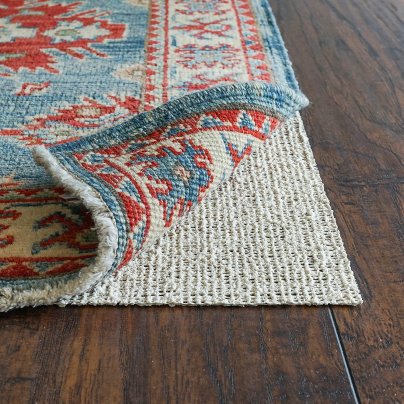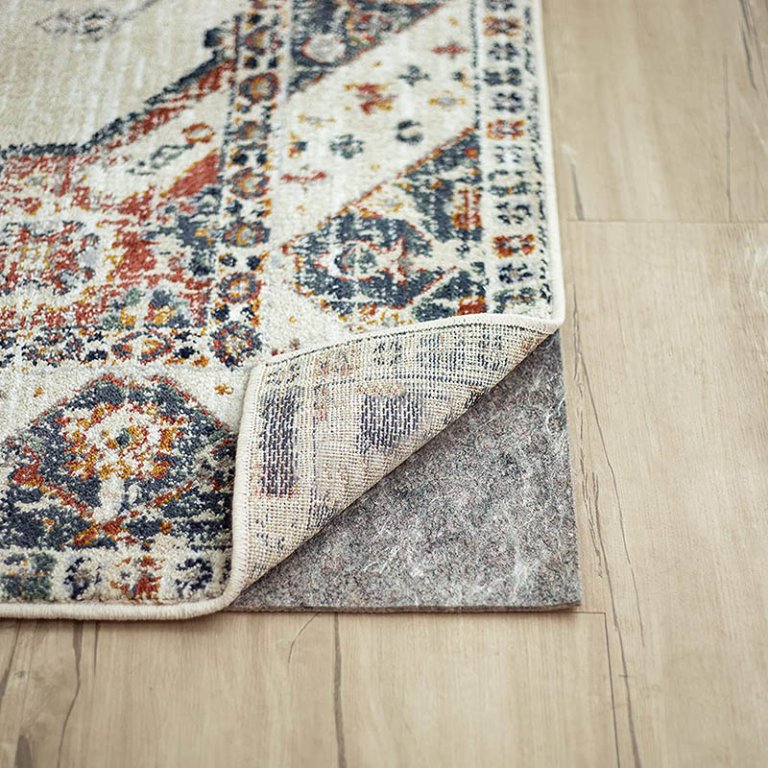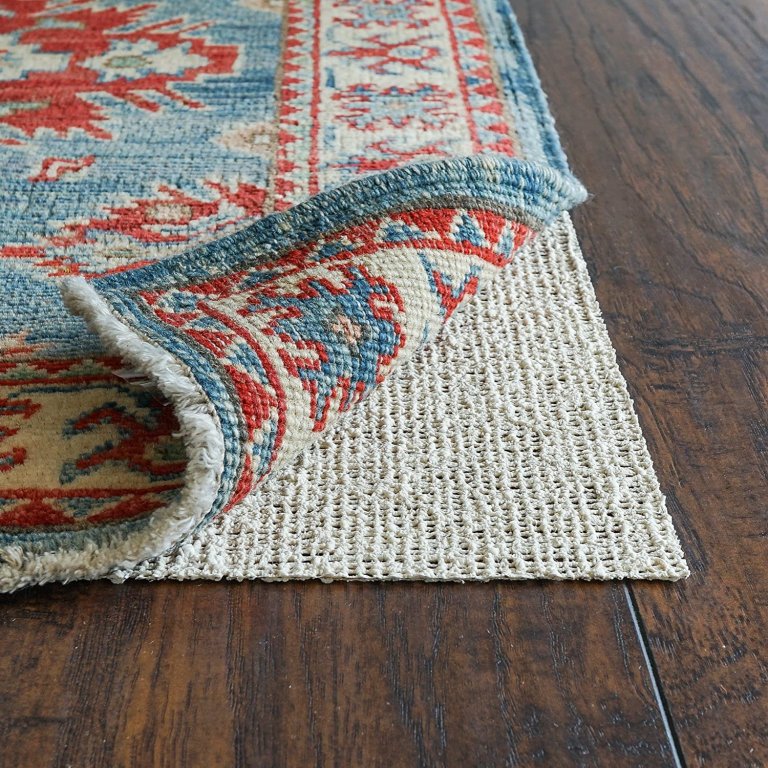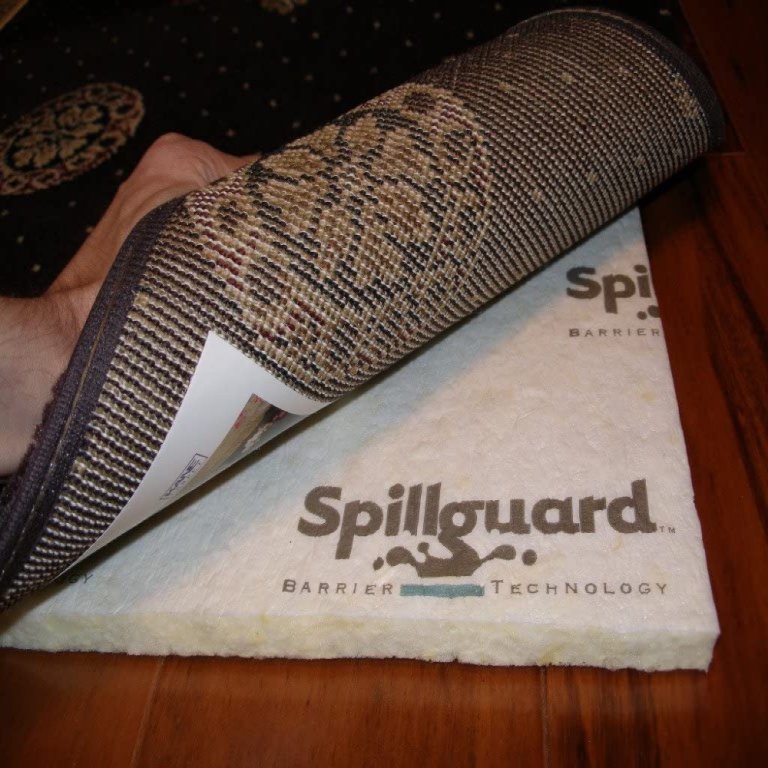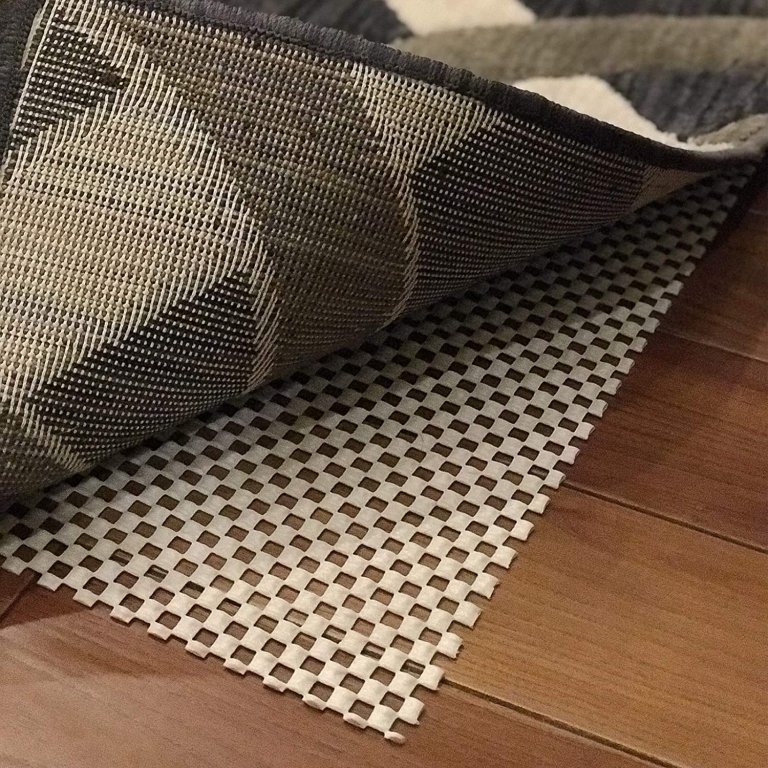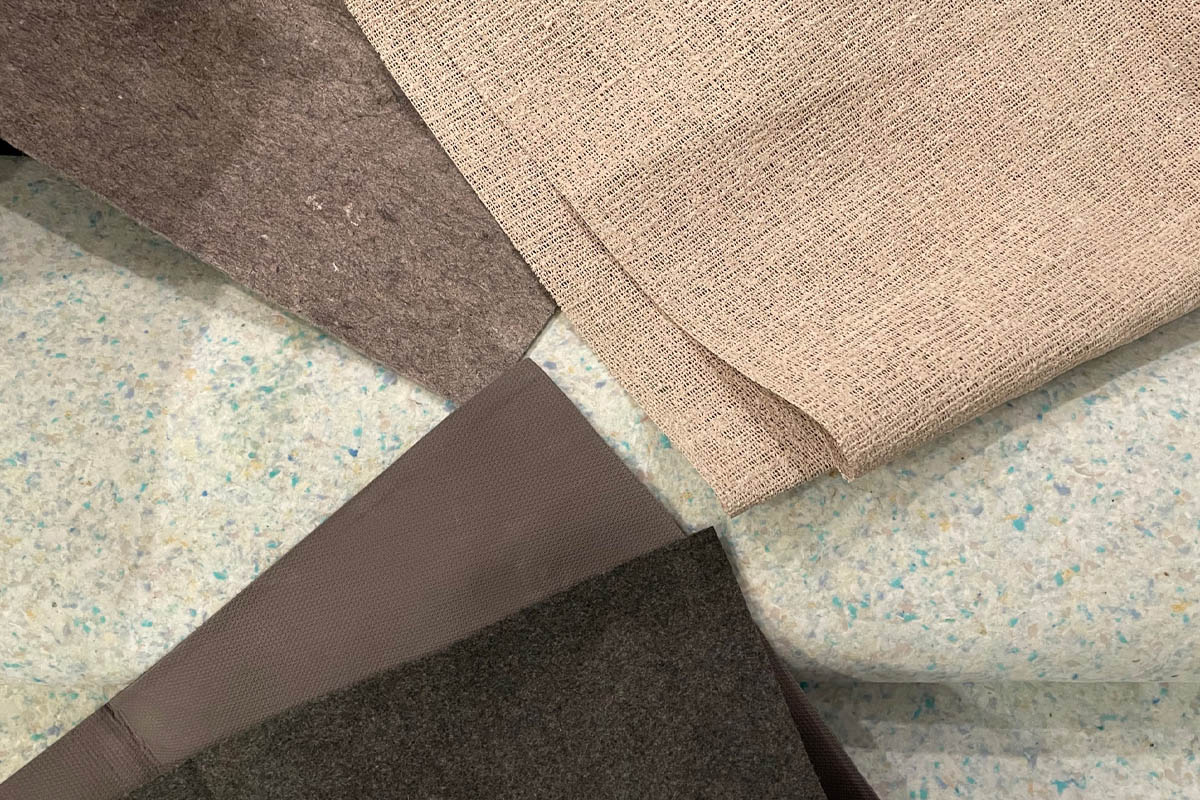
We may earn revenue from the products available on this page and participate in affiliate programs. Learn More ›
Area rugs add warmth to rooms, but without a rug pad to secure them, they can damage your floors or cause an injury. The best rug pads keep your area rugs from sliding and bunching and make your home safer. Depending on the material, rug pads can also add cushioning or even soundproofing. Ultimately, the best rug pad for your home ensures that both your floors and your rug are protected from excess wear and tear. We’ve tested popular options to report back on their quality and functionality.
- BEST OVERALL: Mohawk Home Dual Surface Rug Pad
- RUNNER-UP: Gorilla Grip Thick Felt and Natural Rubber Pad
- ECO PICK: RUGPADUSA Nature’s Grip Eco-Friendly Non-Slip Rug Pad
- BEST WATERPROOFING: Carpenter Spillguard DuPont Barrier Rug Pad
- BEST FOR OUTDOOR USE: iPrimio Non Slip Area Rug Pad
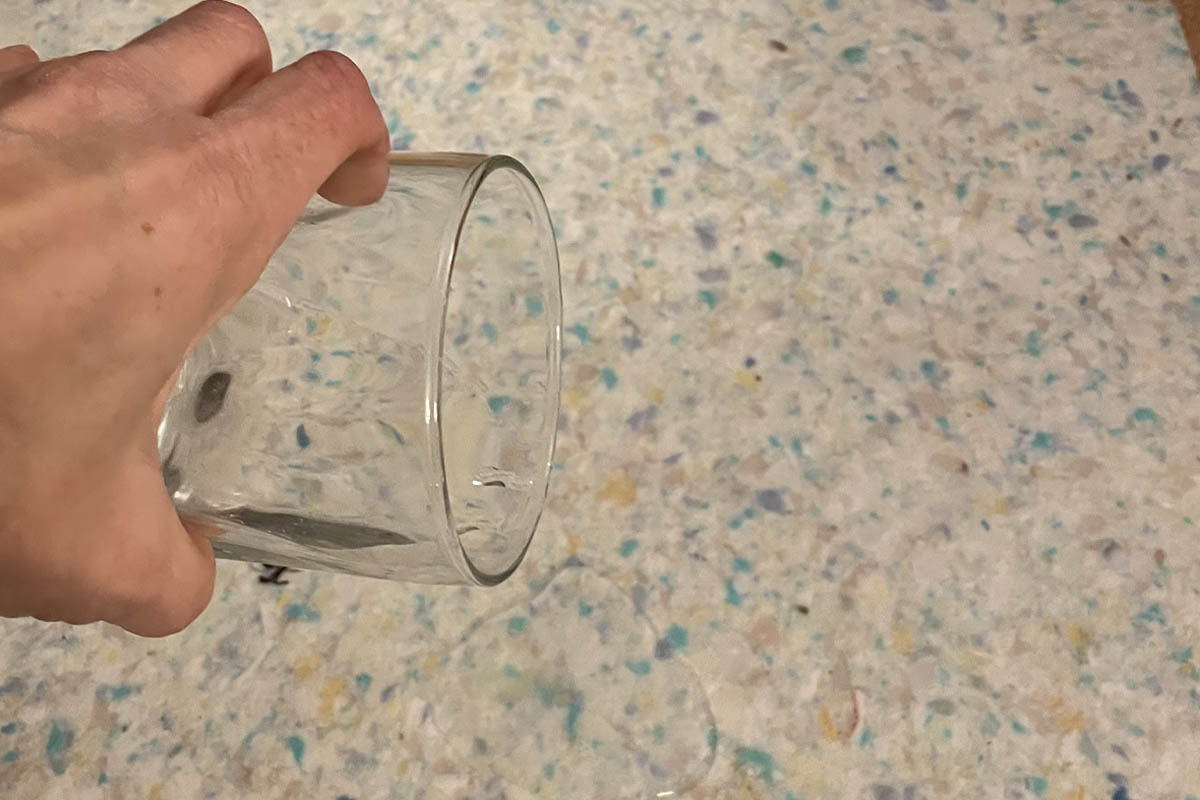
Types of Rug Pads
Rug pads come in a variety of materials. While the differences may seem subtle, they can have a major impact on performance. The best rug pad for you will depend on the style of rug and the purpose you want the rug pad to serve. Read on to find out whether memory felt, rubber, memory foam, or latex is your best bet.
Felt
Felt rug pads come in a range of thicknesses and densities. They provide cushioning and sound insulation and naturally grip your rug. Used alone, felt rug pads don’t grip to the floor very well. However, felt is often combined with a bottom layer of rubber to secure the rug pad. Pads made exclusively from felt work well under rugs made of heavy materials or when furniture is anchoring the rug in place. Felt rug pads don’t hold up well against water, so they’re not the best rug pads for outdoors, kitchens, or bathrooms.
Natural Rubber
Rubber rug pads are derived from rubber tree sap. They’re an eco-friendly, healthier alternative to PVC. (Read about PVC below.) They can be quite thin, so alone, they provide minimal cushioning. They work well with thin rugs or in rooms with low clearance of doorways because they don’t add significant height to your rug. Rubber is ideal for outdoors and in areas that tend to get wet like kitchens and bathrooms. Look for rug pads in 100 percent natural rubber. Additional filler ingredients like sand or clay can compromise quality, and synthetic rubber can damage certain types of floors.
Memory Foam
Memory foam, the same material used in mattresses and pillows, can make for a luxurious rug pad. The extra cushioning that memory foam provides makes it an excellent choice for children’s rooms and playrooms. However, rug pads made exclusively from memory foam don’t provide adequate grip; therefore, a layer of natural rubber will help keep everything in place. Together, they’re a perfect pairing for larger rugs.
PVC
PVC rug pads are an inexpensive option with some downsides. Rugs made from PVC (or polyvinyl chloride) often contain VOCs (volatile organic compounds), which can emit chemicals into the air. Not only is that a potential risk to your family and pets, but PVC can also stain, discolor, or otherwise damage hardwood, laminate, and vinyl floors. PVC pads are less of a problem under outdoor rugs.
Latex
Most budget rug pads contain latex, an inexpensive alternative to rubber. They are cheaper because they include filler ingredients like clay, which can leave a slight residue on your floors with long-term use. They stand up well to water, so they’re a smart choice for outdoors, kitchen, and bathroom.
Hybrid
Some rug pads use a combination of materials to provide a variety of benefits. Dual-layered felt/rubber hybrids are among the best rug pads on the market. They provide the cushion of felt with the grip of rubber. Typically, the top layer is made from felt, which naturally grips the material of the rug, while the bottom layer is made from rubber to grip the floor.
What to Consider When Choosing the Best Rug Pad
Before you choose the best rug pad for your home, consider these key factors. Though you might assume that all rug pads work the same way, several characteristics can affect their functionality. Keep reading to learn about some of the most important qualities to keep in mind when shopping for the best rug pads for your home.
Purpose
Shoppers generally want a rug pad to serve one or both of two purposes.
- Cushioning. Rug pads make your space more comfortable by providing extra support and cushion under your rug. Materials like felt and memory foam are ideal for cushioning your rug. Cushioned rug pads are typically used indoors.
- Safety. Nonslip rug pads keep your rug in place. They are typically made from natural rubber, latex, and PVC. They are best for lightweight rugs in high traffic areas and for use outdoors.
Some rug pads do double duty. They’ll keep your rug in place with a layer of rubber or latex and cushion your steps with added padding.
Cushioning
Many high-quality rugs are well cushioned on their own. But thinner, less expensive rugs can usually benefit from a cushioned pad. Cushioned rug pads provide comfort and a little sound insulation. Felt and memory foam do a good job in the cushioning department. Rubber, latex, and PVC will prevent slipping, but they won’t provide significant cushioning.
Thickness
Rug pads generally range from 1/16-inch to 1/2-inch thick. Rugs of a medium thickness pair well with thick rug pads that add cushioning, hold them in place, and provide additional soundproofing.
If your rug is already on the thicker side, you will likely only need a low-profile nonstick rug pad to prevent slipping and protect both your rug and your floors. But a thick rug pad under a heavy rug can create a truly luxurious feel. Thinner rug pads work well with small rugs and runners that just need to stay in place.
Grip
Rugs that curl or bunch up at the edges increase the risk of falls. High-grip area-rug pads are essential under these rugs. Nonslip pads are especially useful in high-traffic areas to prevent your rug from sliding out of place. They’re also useful in rooms where your rug is not held in place by heavy furniture. Nonslip rug pads are typically made from natural rubber, latex, or PVC. These materials help your rug adhere to the floor.
Dimensions
The rug pad you purchase should be approximately 1 to 2 inches smaller than your rug on each side to ensure the pad isn’t visible and that the edges of the rug aren’t raised. Most rug pads on the market are the same size as standard rugs. You can easily cut them down to achieve the perfect fit.
Eco-Friendliness
When shopping for a rug pad, some may consider whether the product is made from eco-friendly materials. Luckily, some of the best rug pads are made from natural materials like rubber and recycled felt, which are sustainable and don’t contain chemicals that are potentially harmful to you or your family. PVC, on the other hand, isn’t recommended for indoor use because it can emit VOCs that could have adverse effects on both human health and the environment.
Additional Features
- Soundproofing is an added benefit of many cushioned rug pads. Both felt and memory foam pads can provide sound insulation.
- Some rug pads are waterproof and prevent spills from seeping through to your floors.
- Most rug pads require little maintenance, but felt and memory foam pads should be vacuumed annually. If spills occur on felt rug pads, it’s best to blot them to prevent moisture retention.
Our Top Picks
Now that you know more about rug pads, it’s time to start shopping. The following top picks consider the features described above, including material, cushioning, grip, and thickness. We’ve tested each so we can report back on how well they work on different surfaces and with rugs of varying pile heights.
Best Overall
Mohawk Home Dual Surface Rug Pad
Pros
- Suitable for most rug and floor types
- Adds ample cushioning
- Available in 27 sizes
Cons
- Bulky to handle
- Difficult to cut
Product Specs
- Thickness: ¼ inch and ⅜ inch
- Material: Felt and latex
- Number of sizes available: 27
The 100 percent recycled felt of this rug pad cushions your steps, while a latex rubber bottom provides an excellent grip. It is scratchy to the touch and bulky to maneuver, but its ¼-inch thickness offers plenty of cushioning underfoot. The pad felt comfortable and stayed in place when used with both low- and high-pile rugs. It is also available in a ⅜-inch version for those seeking extra cushioning.
Mohawk’s rug pad is suitable for use with various types of flooring, including carpeting, vinyl, and engineered hardwood. We found it difficult to trim, so we recommend choosing your rug first and then opting for one of the 27 available sizes, which include multiple round options. It holds a Green Label Plus Certification by the Carpet & Rug Institute for low chemical emissions.
Get the Mohawk Home rug pad on Amazon, at The Home Depot, or at BedBathandBeyond.com.
Runner-Up
Gorilla Grip Thick Felt and Natural Rubber Pad
Pros
- Padding underfoot in 2 thicknesses
- Made from recycled materials
- Mold and mildew resistant
Cons
- Not suitable for all surfaces, including vinyl
Product Specs
- Thickness: ¼ inch and ⅛ inch
- Material: Felt and rubber
- Number of sizes available: 13
The most versatile rug pads feature a layer of felt and a layer of rubber, like this one from Gorilla Grip. The dense, needle-punched felt feels soft to the touch and provides cushioning and some sound insulation.
Users won’t have to worry about this pad slipping out of place. It effectively grips to the floor, even in the corners. The textured rubber on the bottom helps keep the rug in place without damaging the floors. We noticed comfortable padding underfoot on both low and higher pile rugs.
It’s made from 100 percent recycled material, is naturally hypoallergenic, and is mold and mildew resistant. It was easy to cut to accommodate smaller rugs. One drawback is that this pad shouldn’t be used on carpet, vinyl, lacquered, acrylic, natural stone, porous, or refinished surfaces.
Get the Gorilla Grip rug pad on Amazon or GorillaGrip.com.
Eco Pick
RUGPADUSA Nature’s Grip Eco-Friendly Non-Slip Rug Pad
Pros
- Available in both rectangular and round
- Made from natural rubber and jute
- Low VOCs
Cons
- Has a rubber odor at first
Product Specs
- Thickness: 1/16 inch
- Material: Jute and rubber
- Number of sizes available: 17
Many of the nonslip rug pads on the market use PVC, which can emit chemicals into the air or leach them into the floor. But not this one. RUGPADUSA’s Nature Grip rug pad is made from 100 percent natural rubber and organic jute—breathable materials that help ward off moisture and mold. It is made without chemicals and adhesives to reduce VOCs that can be emitted from home products, especially rugs and rug pads.
At 1/16 of an inch thick, this pad is a great choice for small rugs and runners that don’t need a lot of added padding. The waffle design seemed breathable and felt grippy to the touch. It did have a rubbery smell out of the bag, which faded once it aired out. It was easy to trim with scissors to suit our needs and gripped the floor effectively. It stayed in place with both lower and higher pile rugs, even with kids dancing and running on it.
Get the RUGPADUSA rug pad on Amazon, on RUGPADSUSA.com, or at Wayfair.
Best Waterproofing
Carpenter Spillguard DuPont Barrier Rug Pad
Pros
- Protects floor from water damage
- Thick for added cushioning
- Cons
Product Specs
- Thickness: ½ inch and ⅜ inch
- Material: Visco-elastic memory foam
- Number of sizes available: 13
Pricey
- No nonstick backing
Made with visco-elastic memory foam, this rug pad uses Spillguard Moisture Barrier technology to protect your floor from water damage. This protective layer prevents spilled drinks and other liquids from penetrating the memory foam. Therefore, you can easily blot spills from your rug’s surface and not worry about the other side. We poured a cup of water on it and let it sit, and the rug pad kept our floor completely dry.
The ½-inch-thick pad cushions while it protects, too, adding cushy softness underfoot. One drawback is that it does not have a nonslip backing. We found it moved around when used with lighter-pile rugs, so we’d advise pairing this one with heavier rugs that will stay put. It was easy to cut to accommodate smaller rugs as well.
Get the Carpenter Spillguard rug pad on Amazon or at Walmart.
Best for Outdoor Use
iPrimio Non Slip Area Rug Pad
Pros
- Weather resistant
- Easy to cut
- Affordable
Cons
- Limited sizes available
- Potential for off-gassing of PVC
Product Specs
- Thickness: ⅛ inch
- Material: PVC Foam
- Number of sizes available: 3
The lightly cushioned surface of this nonslip rug pad is made of PVC foam, which is known to withstand temperature changes and outdoor conditions. Its grid construction is breathable and can stand up to harsh weather without trapping rainwater under your rug. We tested it outside during a rainstorm and found it effective against moisture, with no evidence of wetness the following morning. Regular cleaning will help prevent the potential for mold buildup.
Though its primary purpose is for safety, we found it did offer a bit of padding underfoot as well. It stayed in place most effectively with heavier rugs, coming up in the corners slightly with lighter ones. We recommend this option for outside use since it is made of PVC, which can emit VOCs. It is available in three sizes and can be easily cut with scissors to accommodate smaller rugs.
Get the iPrimio rug pad on Amazon.
Our Verdict
We chose the Mohawk Dual Surface Rug Pad as our best overall for its cushiony feel underfoot, its ability to effectively stay in place, and the endless amount of configurations available to suit a variety of rug sizes. The Gorilla Grip Rubber Pad was a close second, offering similar benefits, but for use with more limited flooring types.
How We Tested the Best Rug Pads
In order to effectively test the rug pads on this list, we placed each one under multiple rugs, varying in weight and pile—low, medium, and high. We took note of how well each stayed in place and how comfortable it felt to stand and sit on. Testing included walking, running, and dancing on each to make sure it would stay secured to the ground. We used the pads on different surfaces, including concrete, wood, and vinyl. For the test on the Spillguard, we poured a cup of water on the rug pad and let it sit for 1 hour. While testing the outdoor rug pad, we left it out for multiple days in different weather conditions. Finally, we cut each rug pad to test how easy it was to modify the size and whether that required scissors or a utility knife.
The Advantages of Owning a Rug Pad
You should pair every area rug in your home with a rug pad to protect your floors from wear and tear. Many types of rugs can wreak havoc when placed directly on the floor. Rug pads keep rugs in place so that the corners and edges don’t curl up. They also prevent sliding and bunching, which makes your space safer.
Rug pads can:
- Protect your rugs
- Protect your floors
- Provide added cushioning
- Increase soundproofing
- Prevent slips and falls
- Make vacuuming easier
FAQs
If you still have questions about how to choose the best rug pad for your home, the following frequently asked questions may help.
Q. Can you use a carpet pad for area rugs?
Padding meant for wall-to-wall carpeting is generally incompatible with area rugs and is not recommended. Carpet pads are meant to be attached to carpeting, while rug pads adhere on their own.
Q. How do you measure a rug for a rug pad?
The rug pad you purchase should be 1 to 2 inches smaller than your rug on each side. For example, a 5-by-7-foot rug requires a rug pad that is approximately 4 foot 10 inches by 6 foot 10 inches. Most rug pads come in standard rug sizes that you can trim down to fit your rug.
Q. Which side of a rug pad goes down?
If a rug pad has a sticky layer made from rubber, latex, or PVC, that side should be placed down, touching the floor.
Q. How do you cut a rug pad?
You can cut most rug pads with sharp scissors.


